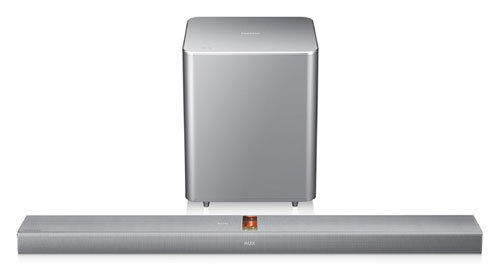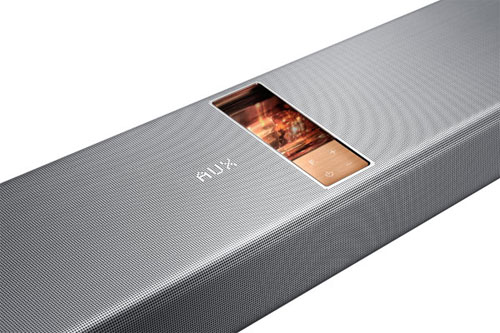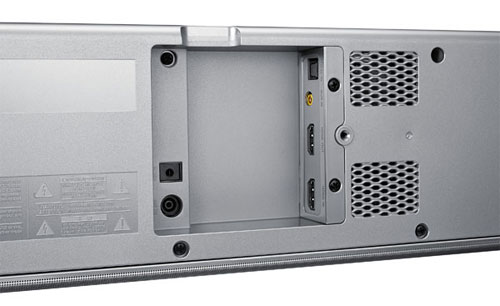For those who don’t have the space or simply don’t want a whole bunch of speakers in their living room, the soundbar is the perfect solution, and it doesn’t come much sexier than Samsung’s HW-F751. Featuring valve amplification, wireless subwoofer and Bluetooth technology, the 2.1 system from the Korean manufacturer looks like a serious contender on paper, so let’s take a closer look…

Note: The specific unit we reviewed was the Samsung HW-F751/XU which is the silver version available to buy in the United Kingdom. A black version, model number HW-F750, is also available for buyers wanting a matching colour for their flat-panel television or surrounding decor. Both should deliver similar performance given identical specifications bar the cosmetics.
The HW-F751 is a beautiful piece of engineering, finished in perforated aluminium, with its crowning glory being the two exposed valves glistening through a small window in the middle. Seated below the valves are touch-sensitive buttons (including volume, power, and function controls) but best of all, to the left of the panel there is a really cool LED display tucked away beneath the perforated mesh which kicks into action when you fire the soundbar up. All other features can be accessed via the Samsung’s remote which comes with the F751.

The soundbar itself can be placed upright or flat on its back, and for whichever position you choose the Samsung HWF751 senses this and adjusts the LED display accordingly. For instance, if you place the unit on its back the built-in sensor recognises this and places the LED display onto the thin front edge – very clever and very stylish! It measures just over 37 inches across so would be best suited to sit under flat-screen TVs of 46 inches and above. It’s safe to say we loved the look and feel of this soundbar.
Moving onto the subwoofer, we couldn’t help but feel that all the design budget had gone into the soundbar, as the sub just looked and felt like an inferior companion compared to the style that adorned the showpiece product. The 6.5-inch driver is housed in a plastic silver cube that just didn’t have the same high quality feel as the soundbar. On the plus side however, it’s wireless which is a massive bonus as you can find the right spot for it and not have to worry about trailing wires, though you will still need to place it near a power point. The subwoofer linking ID is pre-set in the factory and should connect wirelessly as soon as the unit is switched on. In this case it connected seamlessly, but if it doesn’t connect first time it can easily be reset manually.
The Samsung HW-F751 and HW-F750 come with an aux in, optical in, HDMI in, HDMI out ARC (audio return channel), and an auto-calibration input (ASC). On the top of the bar there is also a USB slot which will play AAC, MP3, WAV, WMA, OGG and FLAC files from your USB stick.

The F751 also allows you to stream music via your smartphone or tablet via Bluetooth technology.
Samsung HDTV owners can say goodbye to physical wires, as you’ll be able to connect your television wirelessly to the soundbar via Bluetooth with the Korean manufacturer’s SoundShare feature, allowing for a neat and clean installation. For anyone who doesn’t own a Samsung display, check your TV to see if you have an HDMI input labelled ARC on it. ARC stands for audio return channel, and is an excellent tool for using your TV to output the audio to the soundbar. Connect your Blu-ray or DVD player to the soundbar, and then use an additional HDMI cable to output into the ARC HDMI on your display. Then connect any additional devices to your TV and let the TV via the ARC HDMI switch the sources and output the correct audio to the soundbar.
Actually connecting the leads to the bar was really fiddly, as all the inputs are crammed so close together, so if your HDMI leads are thick you’re going to have a battle on your hands to get them in, and to then get the soundbar to lie flat. Luckily for us, we preferred the sound of the HW-F751 upright so the fact that we couldn’t quite get it to lie flat in the end wasn’t an issue.
On powering up the Samsung HWF751 it was now time to test out the auto-calibration system. Auto-calibration systems can be hit and miss, and nearly always in our experience set the subwoofer far too hot, so let’s see how this soundbar fares. The F751 comes with its own calibration mic, and asks you to plug it into the soundbar via the ASC input and place it in your listening position. With any calibration mics it’s really important to try to place the mic as close to your ear height at your main listening position, rather than just on the seat itself. From our experience, playing the mic at ear height will always give you more accurate results. The best way to do this is to place it on a tripod set to the same height as your ears would be in the listening position. Once connected, the Samsung plays a series of test tones to auto-calibrate the soundbar and subwoofer.
Once it was finished we had a listen to some familiar content in which we knew how the bass should sound, and weren’t surprised that the sub level was too loud and therefore didn’t blend seamlessly with the soundbar. Integrating a subwoofer with a soundbar or your front left and right speakers can be a laboursome and tricky process. The goal is to blend the sub into the system so that it doesn’t become localised. What we mean by this is that you shouldn’t be able to tell where the bass is coming from – rather you should just be able to feel it. As low bass is non-directional there is a consensus that it doesn’t matter where you put the sub in the room. We disagree, as correct sub placement is crucial to getting a great sound and seamless blend with other speakers, or in this case the soundbar. Every room is different and every room will have a sweet spot when it comes to bass and subwoofer placement. Anyone who has a sub already – here’s a tip:
Place the subwoofer in your seating position and put on something with a heavy and steady bass tone. Now walk around the room, or even better (bear with us!) crawl around the room and you’ll hear two things. There will be places in the room where the bass is weak and other places where the bass is strong and full. Mark with tape the points where the bass sounds the best, and if the room allows, place the subwoofer in one of those spots. You may have to recalibrate, but you should have a smoother, tighter bass that will be easier to blend with the rest of your speakers. Try to avoid corners as this often will create unwanted boom.
This was exactly what we did with the Samsung F751 subwoofer, and after running the calibration again we instantly got better results. The calibration mic still set the sub too hot, but the bass was a lot smoother with less boom. Luckily the HWF751 allows you to tweak the sub volume independently, so knocking the sub down to -3 gave us a much better, tighter, and smoother low-end. Auto-calibration can do a good job but at the end of the day sometimes your ear is the best tool.
So now we’re up and running, and happy with the subwoofer position and volume, how did the Samsung HW-F751 sound? The answer was really good.
Sticking with the campus scene from The Incredible Hulk, the HWF751 dug out plenty of detail with a wonderful dynamic soundstage with enough meat at the bottom end to put a big smile on our face. The fun didn’t stop there, as not only did it sound great, but the virtual surround effect enveloped our listening position with a superb illusion of surround sound. Our only real issue was that the subwoofer lost its way sometimes in reproducing the really low end of movie soundtracks. On the whole we were really pleased with the sub’s handling of bass, but occasionally when trying to dig out those low frequencies the bass would drone, and sometimes cause the plastic casing enclosing the driver to vibrate and rattle.
The Samsung F751 comes loaded with various sound processing effects including “Music“, “Drama“, “Cinema“, “Sports“, “Games“, and “Off” which is the original sound with no added effects. These are all accessible via the [Sound Effect] button on the remote. We had a play around with all of them, and it’s safe to say that the HWF751 sounded better with no added effects so we recommend turning them off. There’s also a [3D Sound Plus] option which is supposed to add depth and spaciousness to the sound, but engaging it made everything sound too reverberant so again we chose to turn this off.
The HW-F751 did a really nice job with music sources, again as long as all the sound processing effects were turned off, especially [3D Sound Plus] which just sounded strange with music. We couldn’t say we heard any real added warmth to recordings with the valves on board, but what you do get is a very clear, crisp sound, with vocals and instrumentation reproduced with really nice depth and clarity. Bass response was really good but we would’ve liked just a bit more oomph in the bottom end. Other than that we were more than happy with the way the Samsung F751 handled music sources.
On the whole we were really impressed with the Samsung HW-F751, and with a current street price as low as £429 down from £599 it offers even greater value for money. Impressive sound and stylish looks are only let down slightly by the design of the sub, and its handling of movie soundtracks’ very low frequencies. Even with that in mind, we feel strongly that the HWF751 (as well as the black HWF750) deserves a recommended status.
